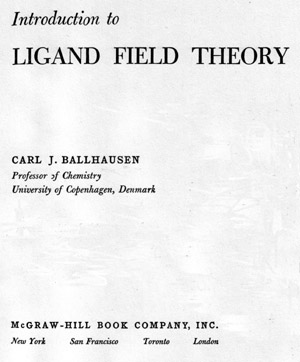 |
 |
 |
 |
 |
Preface to the title at left, 1962 I have tried to give an introduction to that field of chemistry which deals with the spectral and magnetic features of inorganic complexes. It has been my intention not to follow the theory in all its manifestations but merely to describe the basic ideas and applications. This has been done with an eye constantly aimed at the practical and experimental features of the chemistry of the complex ions. The book is thus primarily intended for the inorganic chemist, but it is true that, in order to follow the exposition, a course in basic quantum mechanics is needed. Simple examples are nearly always used to illustrate the arguments, but the quoted experimental evidence must of necessity be limited. Nevertheless, in the last chapter an attempt has been made to cover most of the important work so far performed that lies within the scope of the book. However, the field is advancing so rapidly that a complete survey would be outdated before long. |
Contents
Preface ..................................................... V
Chapter 1 INTRODUCTION ..................................... 1
1-a. History of complexes .......................... 1
1-b. Theories of bonding ........................... 2
1-c. History of the crystal field approach ......... 3
References ......................................... 5
Chapter 2 THEORY OF ATOMIC SPECTRA .......................... 7
2-a. Orbitals and states ............................ 7
2-b. Atomic wavefunctions ........................... 10
2-c. The raising and lowering operators ............. 11
2-d. Matrix elements ................................ 15
2-e. Two-electron operators ......................... 17
2-f. Evaluation, matrix elements (ab|1/r12|cd) ....... 19
2-g. Term energies .................................. 21
2-h. General remarks on the method .................. 25
2-i. Spin-orbit coupling in a hydrogen-like system .. 25
2-j. Spin-orbit coupling in a many-electron case .... 27
2-k. Absolute term intervals ........................ 29
2-l. Zeeman splitting ............................... 30
2-m. Selection rules ................................ 32
References .......................................... 33
Chapter 3 SYMMETRY ......................................... 34
3-a. Concept of symmetry operators ................... 34
3-5. Nomenclature of symmetry operators .............. 36
3-c. Representations ................................. 37
3-d. Important point groups in inorganic complexes ... 41
3-e. Representations and wave functions .............. 43
3-f. The direct product .............................. 46
3-g. Double groups ................................... 49
3-h. The Eulerian angles ............................ 54
References ............................................ 56
Chapter 4 THE CRYSTAL FIELD THEORY: I. FIELDS OF OCTAHEDRAL
SYMMETRY .......................................... 57
4-a. Formalism ....................................... 57
4-b. Octahedrai fields ................................ 60
4-c. Single d electron in a cubic field ............... 62
4-d. Weak fields ...................................... 69
4-e. Strong fields .................................... 74
4-f. Fields of intermediate strength .................. 80
4-g. Computation aids ................................. 84
4-h. Descent in symmetry .............................. 87
4-i. Equivalence of t2g and p electrons ................ 89
4-j. The spectrochemical series ....................... 91
Appendix 1 ............................................ 93
Appendix 2 ............................................ 95
Appendix 3 ............................................ 96
References ............................................ 97
Chapter 5 THE CRYSTAL FISLD THEORY: II. FIELDS OF TETRAHEDRAL
AND OF LOWER SYMMETRY ........................... 99
5-a. Tetragonal fields ................................ 99
5-b. Trigonal fields .................................. 103
5-c. Cis, trans and rhombic fields .................... 106
5-d. Tetrahedral fields ............................... 108
Appendix l ............................................ 111
References ............................................ 112
Chapter 6 SPIN-ORBIT COUPLING ............................... 113
6-a. Importance of spin-orbit coupling ................ 113
6-b. Spin-orbit coupling,one d electron, octah. fields 114
6-c. Spin-orbit coupl.,dn-config.,oct. fields 120
6-d. Spin-orbit split. calc., method Abragam & Pryce .. 124
6-e. g factors in an octahedral field ................. 127
6-f. g factors in a tetragonal or trigonal field ...... 131
6-g. The spin Hamiltonian ............................. 137
6-h. Magnetic susceptibilities ........................ 139
Appendix 1 ............................................ 149
Appendix 2 ............................................ 149
References ............................................ 150
Chapter 7 MOLECULAR ORBITALS ................................ 152
7-a. General discussion................................ 152
7-b. Bonding scheme for an octahedral complex ......... 159
7-c. Estimation of wave functions in an MO acheme ..... 163
7-d. Band intensities in parity allowed transitions ... 170
Appendix 1 ............................................ 174
Appendix 2 ............................................ 177
References ............................................ 178
Chapter 8 VIBRONIC INTERACTIONS ............................ 180
8-a. Vibrational spectra .............................. 180
8-5. Absorption band intens., centrosymmetric complexes 185
8-c. Dichroism ........................................ 192
8-d. Jahn-Teller configurational instabilit ........... 193
8-e. Experimental Evidence of the Jahn-Teller Effect .. 205
References ............................................ 208
Chapter 9 SOME FURTHER ASPECTS .............................. 211
9-a. The Faraday effect ............................... 211
9-b. Optical rotatory dispersion ...................... 214
9-c. "Sandwich" compounds ............................. 217
9-d. Stability of complex ions ........................ 221
References ............................................ 224
Chapter 10 ELECTRONIC STRUCTURES OF SELECTED INORGANIC
COMPLEXES ............................................ 226
Complexes Containing 3d Electrons ..................... 227 VIEW !
10-a. Scandium ...................................... 227
10-b. Titanium ...................................... 227
10-c. Vanadium ...................................... 228
1O-d. Chromium ...................................... 235
10-e. Manganese .................................... 245
10-f. Iron .......................................... 251
10-g. Cobalt ........................................ 255
10-h. Nickel ........................................ 261
10-i. Copper ........................................ 268
Complexes Containing 4d and 5d Electrons .............. 273
10-j. Niobium ....................................... 273
10-k. Molybdenum .................................... 274
10-1. Technetium .................................... 275
10-m. Ruthenium ..................................... 275
10-n. Rhodium ....................................... 276
10-o. Palladium ..................................... 277
lO-p. Tungsten ...................................... 277
10-q. Rhenium ....................................... 278
10-r. Osmium ........................................ 279
10-s. Iridium ....................................... 281
10-t. Platinum ...................................... 282
References ............................................. 283
Index ....................................................... 293
